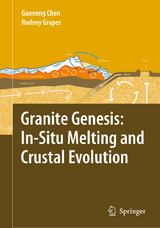Granite Genesis: In-Situ Melting and Crustal Evolution
Springer-Verlag New York Inc.
978-1-4020-5890-5 (ISBN)
Granitic rocks are a major component of the continental crust and the many and complex problems of their origin that have confronted geologists for over 200 years still are presenting challenges today. Current ideas of granite formation involve lower crustal melting, segregation, ascent (as dykes or diapirs) and emplacement in the upper crust.
In this book we suggest an alternative model for the origin of granite in terms of in-situ melting-intracrustal convection that physically determines the process from partial melting of mid-upper crustal rocks to formation of a convecting magma layer. We illustrate the model using geological, geochemical and geophysical studies from Australia, North and South America, Europe and China, and conclude that heat convection within a crustal partial melt layer is essential for the formation of granite magma and that without convection, partial melting of rocks produces migmatites rather than granites. Granite is layer-like within the crust, and shape and size of granite bodies reflect the geometric relationship between an irregular upper surface of the crystallised magma layer and depth of erosion. Repeated melting of the crust generates downward-younging granite sequences. Chemical and isotopic compositions of granites indicate differentiation within the magma rather than different deep sources.
Of a number of proposed heat sources that can cause mid-upper crustal anatexis, large-scale crustal melting and formation of a granite magma layer is considered to be primarily related to plate convergence. A dynamic model with examples from the western Pacific continental margin in SE China and Tethys-Tibet is proposed to explain the relationship between plate convergence, granite and compressive deformation of the continental crust. Mineralisation related to granite formation, fault-block basins, formation of continental red beds and volcanism with examples from SE China, are also discussed in terms of the new model. In a final section, we introduce a new rock cycling model of the continental crust and the concept of Geochemical Fields of Elements, illustrating the unity between the microcosm and macrocosm of the natural world.
Audience: This book will be of interest to scientists, researchers and students in geology, geophysics, geochemistry and economic geology
Preface.- Acknowledgements.- 1 Introduction.- 1.1 Rock genesis and its relationship to geosystems.- 1.2 Granites, migmatites and granite problems.- 2 Crustal melting: experiments and conditions.- 2.1 Introduction.- 2.2 Mineral melting.- 2.3 Rock melting – experimental evidence.- 2.4 Structure and composition of the crust.- 2.5 Water in the crust.- 2.6 Crustal heat and partial melting.- 3. In-situ melting and intracrustal convection: granite magma layers.- 3.1 Introduction.- 3.2 Crustal melting I: Initial melting and partial melt layer.- 3.3 Crustal melting II: Convection and formation of magma layer.- 3.4 Compositional variation within magma layer.- 3.5 Magma layer, granite layer and granite bodies.- 3.6 MI fluctuation (remelting) and granite sequence.- 3.7 Conclusion.- 4. Geological evidence for in-situ melting origin of granite layers.- 4.1 Migmatite to granite.- 4.2 Contact metamorphism.- 4.3 Xenoliths and mafic enclaves.- 4.4 Granite layer and granite exposures.- 4.5 Fluctuation of MI and downward younging granite sequence.- 5. Differentiation of magma layer: geochemical considerations.- 5.1 Introduction.- 5.2 Compositional variation.- 5.3 Strontium isotopes.- 5.4 Oxygen isotopes.- 5.5 Rare earth elements.- 5.6 Summary.- 6. Mineralisation related to in-situ granite formation.- 6.1 Introduction.- 6.2 Source of ore-forming elements.- 6.3 Formation and evolution of ore-bearing fluid.- 6.4 Types of mineral deposits.- 6.5 Age relationships.- 6.6 Temperature distribution.- 6.7 Formation and distribution of hydrothermal mineral deposits.- 6.8 Mineralised depth horizons.- 6.9 Mineralisation during elevated crustal temperatures.- 6.10 Mineralisation during granite remelting.- 6.11 Patterns of element redistribution and element fields.- 6.12 Summary.- 7. Heat source for crustal magma layers: tectonic models.- 7.1 Introduction.- 7.2 Crustal temperature disturbance related to plate convergence.- 7.3 Subduction and granite formation: western Pacific continental margin.-7.4 Continental collision and granite formation: Tethys Belt.- 7.5 Concluding statement.- 8. Geological effects of crystallisation of a crustal granite magma layer: SE China.- 8.1 Fault-block basins.- 8.2. Volcanism.- 9. Material and element cycling of the continental crust and summary.- 9.1. Rock cycling of continental material.- 9.2. Element cycling of the continental crust.- 9.3. Overview.- References.- Appendix 1 map of SE China.- Appendix 2 Results of experimental rock melting.- Index
| Zusatzinfo | 1 Illustrations, color; 217 Illustrations, black and white; XI, 278 p. 218 illus., 1 illus. in color. |
|---|---|
| Verlagsort | New York, NY |
| Sprache | englisch |
| Maße | 160 x 240 mm |
| Themenwelt | Naturwissenschaften ► Geowissenschaften ► Geologie |
| Naturwissenschaften ► Geowissenschaften ► Geophysik | |
| Naturwissenschaften ► Geowissenschaften ► Mineralogie / Paläontologie | |
| ISBN-10 | 1-4020-5890-X / 140205890X |
| ISBN-13 | 978-1-4020-5890-5 / 9781402058905 |
| Zustand | Neuware |
| Haben Sie eine Frage zum Produkt? |
aus dem Bereich




